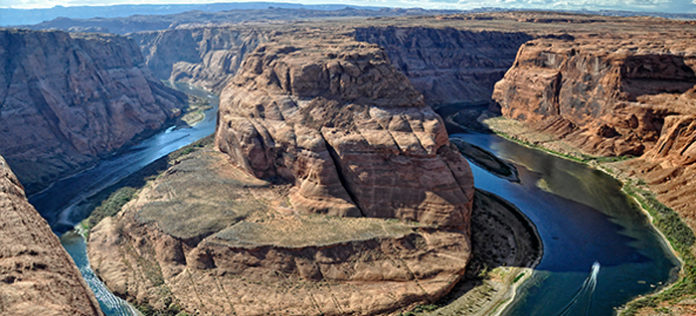
President-elect Joe Biden will face a daunting task in restoring the nation’s system of environmental regulation and confronting a rapidly growing climate crisis after taking office.
Most pressing for the Biden team, and his Environmental Protection Agency, will be the imperative of addressing climate change, an undertaking that began during the Obama administration but was abandoned amid the deregulatory zeal of Trump and his two EPA bosses, Scott Pruitt and Andrew Wheeler. Another priority will likely involve an increased focus on environmental justice.
“Certainly, climate is going to be their leading initiative,” said Jeffrey Davidson, a partner at Kilpatrick Townsend’s Washington, D.C., office and a 40-plus-year practitioner of environmental law. “I think environmental justice … will be the signature issue for the Biden administration.”
Other complex environmental issues also await EPA under the expected leadership of Michael Regan, North Carolina’s chief environmental regulator, who was chosen by Biden as the agency’s next administrator in December 2020. They include an ongoing controversy over the reach of the federal Clean Water Act and contamination of drinking water by per- and polyfluoroalkyl substances (PFAS).
CLIMATE CHANGE
While not an EPA job, first on Biden’s environmental agenda will be a return to the Paris Agreement, the 2015 accord that committed signatory nations to achieve a maximum 1.5 degrees Celsius rise in global average atmospheric temperature above pre-industrialization levels. American greenhouse gas emissions are the second-highest on the planet, trailing only China, and Biden also vowed to put the nation on a track to an economy that produces no net greenhouse gas pollution and is fully powered by renewable energy by 2050.
EPA’s role in achieving that goal will be crucial and will involve use of the country’s principal air pollution law. “The Clean Air Act is really the vehicle for that action,” said Alice Madden, the executive director of the University of Colorado’s Getches-Wilkinson Center for Natural Resources, Energy, and the Environment and a former undersecretary in the Department of Energy.
The Obama administration relied on the Clean Air Act to tighten fuel economy standards on motor vehicles and to impose emission limits on newly constructed or modified stationary air pollution sources. Trump backtracked on both. Trump has attempted to roll back minimum gas mileage requirements — an effort challenged both by a group of 23 state attorneys general that includes Colorado’s Phil Weiser and a coalition of environmental protection advocates — and to weaken so-called New Source Review permitting requirements.
Among the industries that EPA is likely to target in its work to reduce the nation’s contribution to climate change is the fossil fuel sector. “It’s no surprise that there’s going to be a focus on oil and gas,” Randy Dann, a partner at Denver’s Davis Graham & Stubbs, said. He noted the Obama administration’s effort to develop a new source performance standard for oil and gas facilities, which he regards as possibly “fairly expensive and burdensome for the industry,” but also said he thinks there is a chance that a collaborative approach to regulation may arise. “There’s certainly opportunity for coordination and compromise,” he said. “I’ve seen that here in Colorado,” referring to the state’s effort to implement the mandate of a 2019 bill that overhauled Colorado’s system for regulating hydrofracking and fossil fuel extraction site pollutant emissions.
Madden argues that achievement of climate objectives depends heavily on imposing a requirement that allows the government to track actual greenhouse gas emissions. “To my knowledge, there are very few, and none in the federal government that require monitoring of emissions,” she said.
The Obama administration had imposed a rule requiring oil and gas facilities to monitor and limit methane emissions, but Trump discarded it even after three oil giants — BP, Exxon-Mobil, and Shell — asked him not to do so. “Restoring that right away would be huge. If you’re going to drill, you should capture everything that comes out of the ground and account for it,” Madden said. She also warned that natural gas can be part of the nation’s long-term energy mix only if the industry takes the problem of that source’s greenhouse gas pollution seriously, too. “If natural gas wants to stick around, they have to address their emissions problem,” she said. “If they do, it would be a less controversial and cleaner fossil fuel.”
To help the agency achieve Biden’s objectives, and to assure coordination with the rest of the government, former EPA administrator Gina McCarthy and former Secretary of State and U.S. Senator John Kerry will be ensconced in the White House to oversee the climate policy imperative. “They have a lot of experience, obviously, and I think they’ll be setting up their own policy to provide White House and CEQ level reviews,” Davidson said. He was referring to the Council on Environmental Quality, a panel appointed by the president that coordinates U.S. environmental programs.
Ambitious as it may be, the likely Biden climate agenda was delivered an administrative roadblock this week when EPA finalized a rule that excludes any industry-wide emissions source that emits less than 3% of the nation’s U.S. greenhouse gas pollution is to be considered “insignificant” under the section of the Clean Water Act that the Obama administration used to support power plant regulation.
The unexpected measure, say environmental groups, is an effort to undermine Trump’s successor. “In the Trump administration’s latest midnight regulatory gift to polluters, the EPA is perverting the Clean Air Act to ensure that no industry other than the power sector ever has to cut its climate pollution,” said David Doniger, senior strategic director of the Climate & Clean Energy program at the Natural Resources Defense Council. “EPA cannot simply declare by fiat, contrary to the science, that every other industry is too small to matter.”
The new administration’s climate agenda may run into opposition in Congress. Even with Democratic control of both chambers, there may be tenuous support for bold moves. “I don’t know whether there’s going to be sufficient legislative support,” Davidson said. ““I think it’s going to be a very complicated and nuanced [for] Congress going forward.” Madden is more optimistic, stressing that majority Democrats are likely to have learned from their experience early in the Obama administration that it is better to move aggressively on policy priorities than to be cautious. “At a minimum the Dems have these two years,” she said.
WATER POLLUTION
Among the most controversial topics that will confront Regan is the reach of the Clean Water Act. Congress, when it enacted the law in 1972, specified that pollution limits affecting waterways extend only to “waters of the United States.” The Supreme Court, in two decisions released in 2001 and 2006, cast doubt on the meaning of the phrase.
Since then, the definition of that term has been the subject of an enduring controversy. EPA issued a rule that purported to give the term a broad reach in May 2015, when it finalized the Clean Water Rule. Trump, however, made a campaign priority of killing that regulation during his 2016 campaign and, in April 2020, EPA backtracked. His administration’s new rule, called the Navigable Waters Protection Rule, sharply cut back EPA’s jurisdiction.
Marc Yaggi, executive director of Waterkeeper Alliance, said restoring the regulatory definition of “waters of the United States” is crucial for the ecological health of American waters. “The definition is extremely important,” he said. “It’s the underpinning of the entire Clean Water Act.” Yaggi cited Arizona as an example of the not uncommon outcome that could result if Trump’s restrictive approach to EPA regulatory power prevails, saying the state lacks a regulatory mechanism to effectively control water pollution. “When you see waterways no longer protected by the Clean Water Act, that means there’s very likely a gap in protection from pollution in [w]aterways that Americans rely on,” he said.
On the other hand, the Clean Water Rule — which remains in effect in Colorado under a stay granted by a federal judge in litigation launched by Weiser — was unpopular with industry. Agriculture and energy interests, as well as a smattering of states with economies dependent on those sectors, sought to block the regulation in federal court. Nevertheless, according to Davidson, Trump’s move to weaken EPA’s authority under that law is nearly certain to be reversed by the Biden team.
OTHER PROBLEMS
One of the most difficult policy challenges that Biden’s EPA will almost certainly have to deal with involves a ubiquitous class of chemicals called per- and polyfluoroalkyl substances (PFAS). These compounds are found that comes into contact with the substance; in common household products including fabrics, non-stick products or cleaning products; in factories; and in fire-fighting foams that contaminate groundwater. A 2018 report by the Centers for Disease Control found that exposure to the compound can cause birth defects, cancer, decreased fertility, developmental disorders, liver damage and increased risk of asthma and thyroid disease.
EPA has used the Toxic Substances Control Act to ban the manufacture, processing or import of products that contain “long chain” varieties of the compound without the agency’s approval, yet it has not completely banned PFAS. It is widely anticipated that Biden will move to regulate it more comprehensively, Davidson said.
Installing and enforcing a regulatory scheme that would reduce the pervasive presence of PFAS would be expensive. “If you were to make PFAS a hazardous substance that might potentially trigger potential liability for anyone who releases,” Davidson said. “It won’t be easy as saying PFAS is a hazardous substance. Putting it on the Safe Drinking Water Act standard is one way, but someone is going to have to pay for water companies to deliver water with the extremely low levels.”
Coal ash, too, looms as a regulatory challenge for Biden’s EPA. Produced whenever coal is burned, the substance commonly ends up in landfills or impoundments. If not safely stored, and if released to the environment, coal ash causes profound danger to public health and aquatic ecosystems. Litigation over a rule to regulate coal ash as a hazardous substance under the Resource Conservation Recovery Act issued by the Obama administration and backtracking by Trump’s EPA have left the future of coal ash regulation murky. Public health advocates and environmental protection organizations are likely to push for a more restrictive approach after Regan takes control of the agency.
ENVIRONMENTAL JUSTICE
Biden has stressed the urgency of advancing environmental justice to the top of EPA’s agenda. “Any sound energy and environmental policy must advance public health and economic opportunity for all Americans, in rural, urban, and suburban communities, and recognize that communities of color and low-income communities have faced disproportionate harm from climate change and environmental contaminants for decades,” proclaims a campaign website. The president-elect has indicated he will create a division within the Department of Justice to oversee compliance with environmental justice directives, reinvigorate EPA’s Civil Rights Compliance Office and strengthen monitoring and notification requirements.
Madden thinks Biden is fighting the tide of bureaucratic inertia in this arena. “The whole environmental justice movement is incredibly important, and EPA has not done a good job on that,” she said. Nevertheless, Biden’s ideas to improve the situation are promising and may have bipartisan support. “The society today in 2021, with the issues of racial justice and systemic racism issues, I think there’s a great movement and great groundswell of support for an environmental justice initiative,” Davidson said.
The details are where the effectiveness of any environmental justice program will stand or fall. Madden pointed out that EPA has not effectively used authority granted it under federal civil rights laws to confront the problem of disparate environmental impacts in low income neighborhoods, while the Department of Justice under Trump has strove to eliminate settlement tools that can be used to require polluters to compensate contaminated communities. Nor has EPA’s internal environmental justice staff made much difference to date. “There’s EPA’s Office of Environmental Justice, which was created in 1993, but it hasn’t done too much,” Madden said.
EPA RESOURCES
None of Biden’s environmental policy priorities are likely to be achieved unless EPA is adequately staffed and provided with a budget sufficient to finance work on them. Since fiscal year 2010 EPA’s budget has fallen by more than 12%, while the number of agency employees is down by nearly 3,000 in that period. Many of the losses of personnel included senior agency staff, including scientists.
Madden emphasized the critical nature of that resources crunch, while Davidson said Biden should not overlook the benefits of entrusting more of the nation’s environmental policy to the states and give consideration to the best way to think about whether enforcement of the law is effective. “Various state organizations have been pleased with greater respect and greater flexibility and greater respect in providing for enforcement,” he said. “I do think that this EPA, and all EPAs, should take a harder look at what constitutes proper metrics to evaluate enforcement. Is it the number of cases brought, the amount of fines?”
For Yaggi, EPA’s effectiveness under Biden will be advanced in the aftermath of “sloppy” regulatory actions by Trump regulators. “They’ve let their zeal for doing the bidding of polluters outpace their attention to detail and to the law,” he said. Davidson, meanwhile, said that, in his experience, it is reasonable to have confidence in those chosen by the new president to lead the agency. “These are people who are doing their best to solve problems,” he said. “They know what they’re confronting on the political side of life. They’re going to take a very measured, strategic, and thoughtful approach to addressing environmental issues going forward.”
This article appears in the Jan. 11 issue of Law Week Colorado. To read other articles from that issue, order a copy online. Subscribers can request a digital PDF of the issue.




